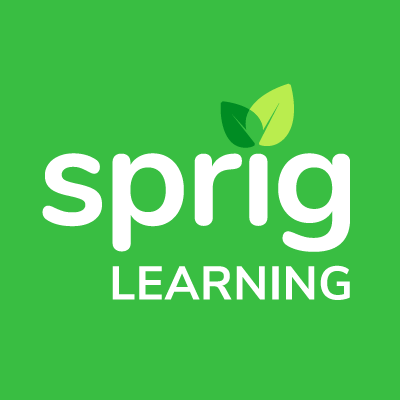This article was originally published at https://www.canadadownunder.org.au/sprig-learning/
Jarrett Laughlin comes from a family of Canadian educators. As someone with nearly two decades of experience in the Canadian education sector, his passion and work are dedicated to closing the learning gaps for marginalized students.
During a routine parent-teacher meeting when Jarrett’s son was five years old, the teacher told Jarrett that she was concerned about his son’s oral language development.
The teacher was unable to assess his son Jacob, because he didn’t talk at school.
Jarrett knew where this was going. He knew there would eventually be discussion about putting Jacob on an Individual Learning Plan, but he also knew Jacob’s speaking skills were not the issue.
“Jacob is the last of my four children, and at home he’s always trying to be heard and does not stop talking,” said Jarrett.
“He has one level of volume – and it’s really loud!”
“It dawned on me that he must have been shy or uncomfortable in the classroom – not in a space where he was willing to use his voice.”
This moment led Jarrett to reflect on the wider challenges that communities, schools, teachers and parents face in supporting and shaping children during their early learning years.
These foundational years are so critical to a child’s long-term educational success, and Jarrett acknowledged that without intervention that “this could have really influenced Jacob’s learning path and learning journey.”
Working together, Jacob’s teachers and Jarrett supported Jacob and boosted his confidence, so he could demonstrate his oral skills in the classroom.
With over 15 years’ experience working in Indigenous education, Jarrett recognizes that many students – especially those who are disadvantaged or from diverse backgrounds – often struggle to access the personalised support they need to excel at school.
“This [Jacob’s case] was a Caucasian child with a Caucasian teacher in a high socio-economic school. Think about how this happens every day, for thousands of marginalized students across this country.”
Sprig Learning is established
After this experience, Jarrett was driven to establish the education technology company called Sprig Learning. The company founded its first early learning program, Sprig Language, which uses a holistic approach to early literacy and language development by encouraging learning both inside and outside the classroom.
Having worked as a teacher, policy advisor and advocate at all levels of government, Jarrett has witnessed a number of heart-breaking journeys for students struggling to navigate the education system.
This experience has given him a rich understanding of the many educational challenges and opportunities that exist across Canada.
In particular, his passion lies in Indigenous education, where he has worked with Indigenous teachers and communities to identify and address the many disadvantages that are unique to Indigenous students.
“Many Indigenous students in Canada start their learning journey by leaving their communities and are enrolling in unfamiliar schools with unfamiliar teachers, who bring with them innate cultural biases and stereotypes about Indigenous children. In many situations, this scenario caused inaccurate assessments for students and has led to many students getting off on the wrong educational path so early in life.”
“We can do better. Every child deserves a fair shot of success in education.”
Sprig Learning’s Mission
“[At Sprig Learning], we focus on education equity. The foundation of successful learning is not just built on equality, but equity. The unique needs of every student, especially marginalized students, must be met.”
“We focus on the foundational key milestones in those early years that lead to success later in life.”
Studies show there is a strong correlation between reaching early literacy milestones by age eight and completing high-school by age 18.
“Generally, up to age eight, children are learning to read. After that, they are reading to learn. After age eight this is a pivotal point where curriculum often shifts and accelerates. This is the point where many students on the margins are lost, and teachers find it difficult in large classrooms to support these students.”
How does Sprig Learning enhance literacy?
Personalisation is an important element of all Sprig Learning’s programs, and Jarrett explains that Sprig Learning’s technology identifies a child’s unique strengths, needs and abilities.
“The first step is a holistic assessment. At the school, students have a conversation with a puppet – his name is Antle in the Mi’kmaw language.”
The teacher will hold the puppet in one hand and an iPad in another which observes and records the interaction, collecting data. Through this interaction, the technology assesses the child’s vocabulary, grammar, storytelling strategies, clarity of speech and comprehension.
The puppet and iPad are not only a fun way to engage children, but they help limit any cultural, racial or gender biases a teacher may have.
Sprig Learning’s technology then uses artificial intelligence to analyze the assessment results and personalizes a learning journey for each child.
The outcome is a set of personalized learning activities, for each child, that reflects their needs and interests. Teachers are guided to complete these activities in the school, while parents are supported to complete them at home with their child.
“Not only is there a student assessment, but we survey parents, and they [tell us] about how they support oral language in the home. Are they speaking in multiple languages? Are they reading to their child, talking with them, telling stories, counting, singing, rhyming? We engage with the elders in the community and also with the teachers.”
“So, we use multiple perspectives to help understand the child’s oral language learning in the home, the community and the school. It really brings out a holistic understanding about what’s needed to support that child.”
As was the issue in his son’s case, Jarrett knows that the right support doesn’t just improve a student’s academic skills, but also their social, emotional and mental well-being.
“When we can really recognize them, identify not just their learning gaps, but their strengths and their interests, the students feel respected and understood. They feel included in the classroom and in the conversation.”
“That trickles down socially and emotionally to so many other attributes,” he said.
Connecting within communities
Today, Sprig Learning is used in more than 100 schools across Canada and supports the learning and delivery of 11 different Canadian Indigenous languages.
Jarrett and his team have worked hard to advocate across Canada and internationally connecting with key decision makers within the government, school districts and community, including curriculum leads, early learning leads, and champions of Indigenous education.
“We do a lot of work to understand the challenges and pain points of education systems and to make sure that our programs are helping to solve their problems. Many of the challenges we hear are around equity and inclusion and providing support for parents and teachers.”
The ability to customise the platform for a range of languages was essential to the partnership in 2015 with the Mi’kmaw Indigenous community.
“With our widespread reconciliation work here in Canada, there is a real focus on the revitalization and reclamation of Indigenous languages which is a key part of the social fabric of this country.”
The Mi’kmaw not only wanted to enhance the English literacy of their students, but most importantly revitalize and grow their Mi’kmaw language with equal importance. Working alongside community and provincial education authorities, the Indigenous community led the way in shaping the program.
It was tailored to suit the needs of the community and incorporated the knowledge and perspectives of the Elders by integrating stories, language and cultural elements.
Jarrett said that the partnership has seen significant improvements for students, and this has been backed up by teachers.
“We are seeing lots of success [in student outcomes] already, including increased engagement, and increased language acquisition.”
“There is a formal study underway with St. Francis Xavier University who will assess the longitudinal outcomes.”
Jarrett is reminded of how one of the Grade 1 Mi’kmaw teachers said that the improvements were clear.
“She said she was already a month into the classroom and already the understanding of the Mi’kmaw language is ahead of where she would normally be two months from now.”
Lessons learned
The partnership has also been fruitful from a business perspective in working with other educational partners.
“My work over the years has helped me reflect on how Indigenous pedagogy and worldview can help support all education systems across the world as they look to improve and reform,” said Jarrett.
“Indigenous education is reflected through holistic, lifelong learning models, which are built on a community-based approach to education that supports each and every learner.”
Of course, closing the education gap is only one part of the reconciliation story. One particular moment that has stuck with Jarrett involves a parent of a child who was undertaking the Sprig Language program.
This parent had a grandmother who attended a residential school as a child, bringing with her decades of terrible trauma associated with this experience. This parent had found it difficult to participate in their child’s school activities or even visit the school. For them, school was not a safe place.
However, when her child’s class had a birthday party for their puppet Antle, the child and their parent both came to the school to celebrate the event.
Initially nervous, the parent stayed in the hallway before being welcomed into the classroom by the teacher and the puppet in the Mi’kmaw language.
This experience demonstrated to Jarrett that the puppet was not just a tool to teach language and build literacy skills, but also allowed people of all ages to break boundaries and build connections between the home and school.
The future of Sprig Learning
With these successes in mind, Jarrett believes that this is only the beginning for Sprig Learning.
During a trip to Australia to speak at the World Indigenous Education Conference back in 2008, Jarrett has seen the similarities between Canadian and Australian school system, realizing the potential for Sprig language in this country.
With a commitment of protecting and preserving Indigenous languages in Australia, Sprig Learning is a program with proven results and the ability to adapt to an Australian context. But whether the next step is to expand in Australia or elsewhere, it is clear that there are benefits to be realised not just by students, but by parents, teachers, and communities worldwide.
When asked about his hopes for Sprig Learning in the future, Jarrett’s passion for equitable education is clear.
“I want to see as many students and families have broader access to Sprig’s early learning programs so that every child can have a fair shot at success in education.”
For tips and suggestions on how to engage your kids at home, follow Sprig Learning on:
Facebook: https://www.facebook.com/SprigLearning
Twitter: https://twitter.com/SprigLearning
Instagram: https://www.instagram.com/spriglearning
For access to free educational resources for children aged 3-6, sign up to Sprig Home today for free: https://www.spriglearning.com/sprig-home/


